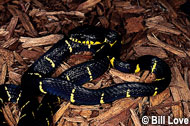Description:
As a large, arboreal species, the mangrove snake needs a large terrarium at least 4 feet long and 3 or 4 feet high. There should be many climbing branches, vines and resting platforms in the terrarium, especially near the top, as this species takes it food by ambushing it from above. A large water bowl is necessary to help maintain humidity of 80 percent to 90 percent and as a bath. This water should be changed daily. An average temperature between 85 and 95 degrees Fahrenheit is necessary, dropping slightly at night. Many specimens appreciate a heat lamp near the top of the terrarium. The substrate should be one that can hold substantial moisture and the terrarium itself must be waterproofed. Mangrove snakes are nocturnal ambush predators that take a variety of foods, depending on size and age of the snake. Young specimens prefer frogs, lizards, and even large slugs, while large adults will take young rats and small birds. Many specimens will take fish in their water bowl. Most specimens are wild-caught and should be carefully vetted for parasites. This species generally is nervous, has a vicious temper, and should not be handled. It is a venomous rear-fanged snake whose bite has caused dangerous reactions in keepers who have been bitten, though deaths have not been substantiated. Anyone keeping this species should be aware of its dangers.
Habitat:
A species living in coastal mangrove swamps and humid forests, usually near water. It often is found resting on branches over water and is not afraid to swim across streams when disturbed.
Range:
This is a species of tropical Southeast Asia, ranging from southern Thailand over Indonesian islands and the Philippines.
Scientific Name: Boiga dendrophila
Species Group:
Family: Colubridae, Boiginae
Size: 5 to 6 feet
Level: advanced
Weight:
Dangerous: No


